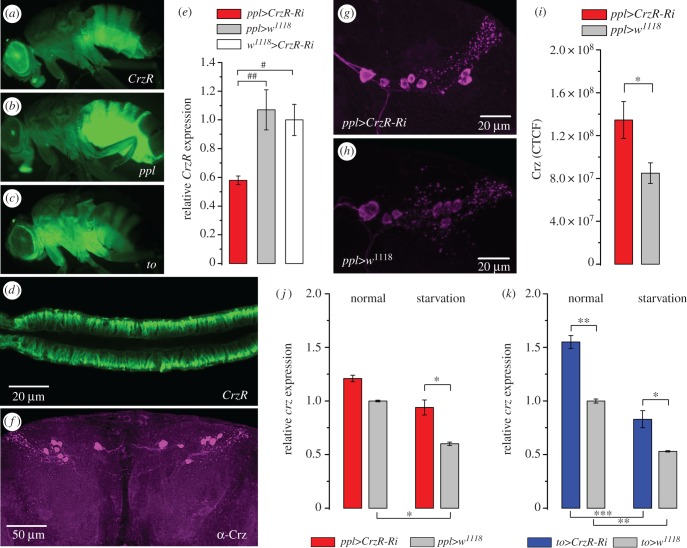Figure 1.
The corazonin receptor (CrzR) is expressed in adipocytes of D. melanogaster fat body and its knockdown leads to a compensatory increase of corazonin peptide (Crz) and transcript (crz) expression. (a) The CrzR is expressed in the adult fly fat body (CrzR>GFP), mainly in the abdomen. (b,c) Two different Gal4 drivers (ppl-Gal4 and to-Gal4) display GPF expression in adult flies. These were used for targeting UAS-CrzR-RNAi in subsequent experiments. In electronic supplementary material, figure S1a–d, we show details of GFP expression, as well as GFP expression in other tissues. (d) Expression of CrzR in salivary gland revealed by CrzR-Gal4>UAS-GFP). (e) CrzR-RNAi efficiency was tested by qPCR in ppl>CrzR-RNAi flies (ppl>CrzR-Ri). The efficiency for the CrzR-RNAi driven by an actin-Gal4 is shown in electronic supplementary material, figure S1e. (f) Corazonin-immunolabelling is found in a set of seven dorsolateral peptidergic neurons (DLPs) in each brain hemisphere (shown in w1118 fly). (g–i) Knockdown of CrzR in fat body/salivary glands by ppl-Gal4 induces an increase of CRZ expression in DLPs. (j,k) Using ppl-Gal4 and to-Gal4 to drive CrzR-RNAi results in increased crz transcript levels, especially after 36 h starvation. Data in graphs are presented as means ± s.e.m., n = 3–4 independent replicates with 8–12 flies in each replicate. (e) Kruskal–Wallis's test followed by pairwise comparisons using Wilcoxon's rank sum test with #p < 0.05, ##p < 0.01, (i) Student's t-test with *p < 0.05, **p < 0.01 and (j,k) ANOVA followed with Tukey's test p < 0.05, **p < 0.01, ***p < 0.001.

